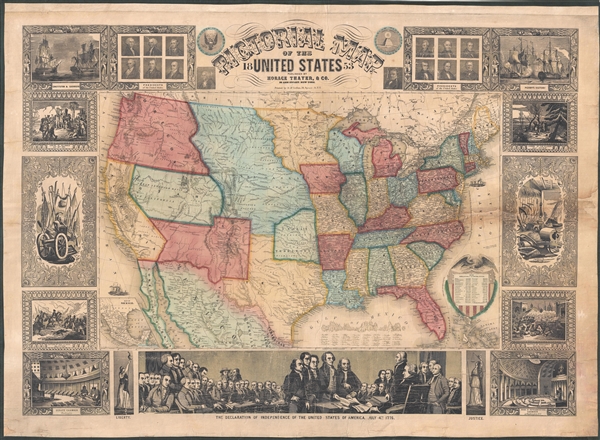
This item below is out of stock, but another example (left) is available. To view the available item, click "Details."
Details
1853 Thayer Pictorial Wall Map of the United States
$3,500.00
1853 Thayer Pictorial Wall Map of the United States
PictorialMapoftheUnitedStates-thayer-1853
Title
1853 (dated) 31 x 43 in (78.74 x 109.22 cm) 1 : 6336000
Description
True its descriptive title the map is surrounded by numerous pictorial vignettes illustrating, from the title clockwise: the Presidents of the United States, Perry's Opening of Japan, the Landing of the Pilgrims in 1620, farm tools, the 1846 Battle of Monterrey (Mexican American War), the United States House of Representatives Chamber, an illustration of Justice personified, the signing of the Declaration of Independence (largest illustration, bottom center), a personification of Liberty, the Senate Chamber, the capture of General La Vega 1846 (Mexican American War), weapons and armor, the landing of Columbus 1492, the Constitution and Guerriere (Navy Ships), and again, the Presidents.
This map was first issued by Ensign and Thayer in 1847. It was republished by Ensign and Thayer in 1849 (Rumsey 5057), 1850, and 1852 (Rumsey 3508), and then in its present form by Thayer alone in 1853, and again Ensign, Bridgman and Fanning in 1854, and 1855 (Rumsey 265). A final edition by Ensign, Bridgman and Fanning appeared in 1858.
CartographerS
Horace Thayer (June 29, 1811 - March 15, 1875) was a New York based publisher and lithographer active in New York City and Buffalo, New York, during the middle part of the 19th century. Thayer's publications focused on travel guides, wall, and pocket maps - many of which were based on the works of other American cartographers including J. H. Colton and S. A. Mitchell. In the 1840s, he partnered with the Hartford, Connecticut publisher Timothy Ensign (1795 - 1849) and later his son, Edward Hooker Ensign (1818 - 1871). According to map historian Walter Ristow, J. H. Colton's older son, George Washington Colton, partnered with Thayer in the late 1850s and early 1860s, possibly in order to learn Thayer's lithography techniques. Certainly a number of maps emerged bearing a 'Thayer and Colton' imprint. At various points Thayer also published with other prominent publishers and printmakers, publishing as Kelloggs and Thayer (1846 - 1847), Ensigns and Thayer (1848), Ensign and Thayer (1849 - 1850), and Ensign, Thayer, and Company (1850 - 1851), Phelps and Watson (1859), and Thayer and Colton (1859-186?). Thayer seems to have moved frequently and had offices at 50 Ann Street, 156 William Street, and at 18 Beekman Street, all in New York City. More by this mapmaker...
John M. Atwood (1817 - October 12, 1884) was an American engraver based in Philadelphia and New York City during the middle part of the 19th century. Atwood was born in Georgetown, near Washington D.C. Little is known of Atwood's life but most of his work was completed in conjunction with the publishing firms of Horace Thayer and J. H. Colton. A review of Atwood's work suggests that he was a highly accomplished, stylistically distinct, and detail oriented engraver. Colton seems to have turned to Atwood to engrave some of his most important as well as decorative maps. His most influential map is most likely the 1856 De Cordova pocket map of Texas, however, he also engraved the Colton's well known and highly decorative Thirty Three Miles Around New York and Colton's important 1849 Map of the United States. Learn More...

